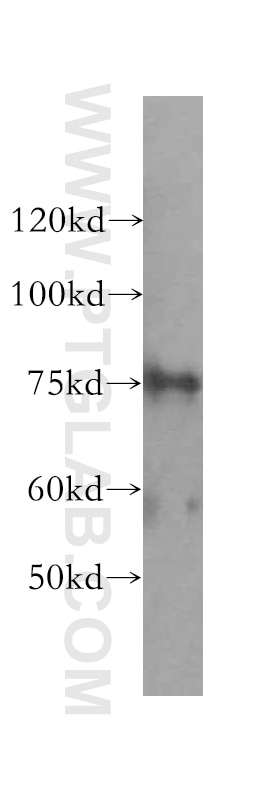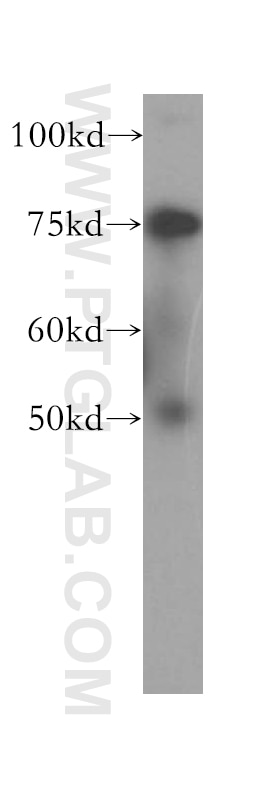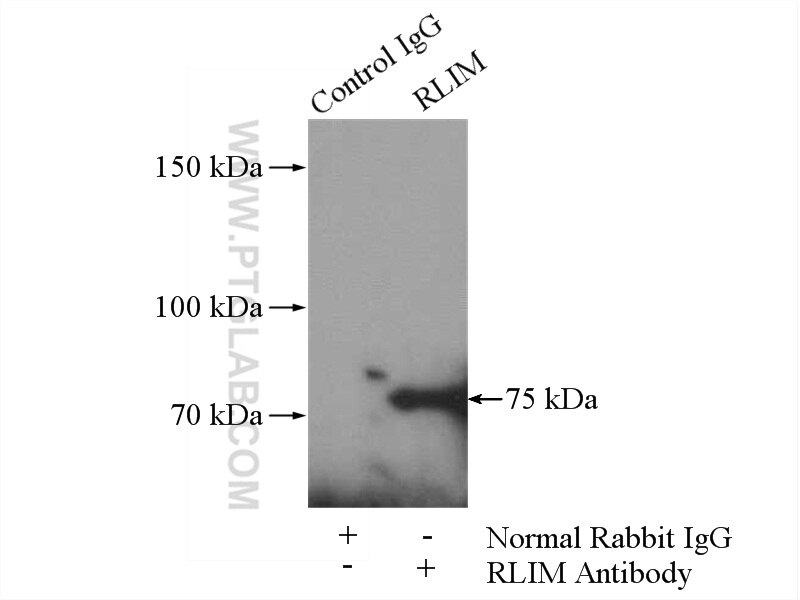- Phare
- Validé par KD/KO
Anticorps Polyclonal de lapin anti-RLIM
RLIM Polyclonal Antibody for WB, IP, ELISA
Hôte / Isotype
Lapin / IgG
Réactivité testée
Humain, rat, souris
Applications
WB, IHC, IF, IP, CoIP, ELISA
Conjugaison
Non conjugué
N° de cat : 16121-1-AP
Synonymes
Galerie de données de validation
Applications testées
| Résultats positifs en WB | cellules HeLa, cellules Jurkat |
| Résultats positifs en IP | cellules HeLa |
Dilution recommandée
| Application | Dilution |
|---|---|
| Western Blot (WB) | WB : 1:500-1:2000 |
| Immunoprécipitation (IP) | IP : 0.5-4.0 ug for 1.0-3.0 mg of total protein lysate |
| It is recommended that this reagent should be titrated in each testing system to obtain optimal results. | |
| Sample-dependent, check data in validation data gallery | |
Applications publiées
| KD/KO | See 2 publications below |
| WB | See 5 publications below |
| IHC | See 1 publications below |
| IF | See 1 publications below |
| IP | See 1 publications below |
| CoIP | See 1 publications below |
Informations sur le produit
16121-1-AP cible RLIM dans les applications de WB, IHC, IF, IP, CoIP, ELISA et montre une réactivité avec des échantillons Humain, rat, souris
| Réactivité | Humain, rat, souris |
| Réactivité citée | Humain, souris |
| Hôte / Isotype | Lapin / IgG |
| Clonalité | Polyclonal |
| Type | Anticorps |
| Immunogène | RLIM Protéine recombinante Ag9077 |
| Nom complet | ring finger protein, LIM domain interacting |
| Masse moléculaire calculée | 624 aa, 69 kDa |
| Poids moléculaire observé | 75 kDa |
| Numéro d’acquisition GenBank | BC013357 |
| Symbole du gène | RLIM |
| Identification du gène (NCBI) | 51132 |
| Conjugaison | Non conjugué |
| Forme | Liquide |
| Méthode de purification | Purification par affinité contre l'antigène |
| Tampon de stockage | PBS with 0.02% sodium azide and 50% glycerol |
| Conditions de stockage | Stocker à -20°C. Stable pendant un an après l'expédition. L'aliquotage n'est pas nécessaire pour le stockage à -20oC Les 20ul contiennent 0,1% de BSA. |
Informations générales
RLIM (RING finger LIM domain-binding protein), also known as RNF12 (RING finger protein 12) or NY-REN-43, is a 624 amino acid RING-H2 zinc finger protein that is involved in protein ubiquitinylation and subsequent degradation. Expressed in a variety of tissues, RLIM binds to the LIM domain of various proteins and functions as a protein ligase that negatively co-regulates LIM homeodomain (LIM-HD) transcription factors. Through its interaction with Sin3A, a component of the histone deacetylase corepressor complex, RLIM is able to recruit the corepressor complex to LIM-HD proteins, thereby inhibiting LIM-HD transcription. In addition to recruiting the deacetylase complex to LIM-HD proteins, RLIM is able to bind to, ubiquinate and subsequently degrade CLIM proteins, which function as positive co-regulators of LIM-HD transcription factors. RLIM contains one RING-type zinc finger and is implicated in renal cell carcinoma. The calcualted molecular weight of RLIM is 69 kDa, but modified RLIM is about 70-75 kDa.
Protocole
| Product Specific Protocols | |
|---|---|
| WB protocol for RLIM antibody 16121-1-AP | Download protocol |
| IP protocol for RLIM antibody 16121-1-AP | Download protocol |
| Standard Protocols | |
|---|---|
| Click here to view our Standard Protocols |
Publications
| Species | Application | Title |
|---|---|---|
Cell Death Dis RNF12 is regulated by AKT phosphorylation and promotes TGF-β driven breast cancer metastasis. | ||
Oncotarget PIWIL1 destabilizes microtubule by suppressing phosphorylation at Ser16 and RLIM-mediated degradation of Stathmin1. | ||
J Mol Cell Biol Sequential stabilization of RNF220 by RLIM and ZC4H2 during cerebellum development and Shh-group medulloblastoma progression.
| ||
Nat Cell Biol Phase separation of ERCC6L2-CtIP regulates the extent of DNA end resection
|




